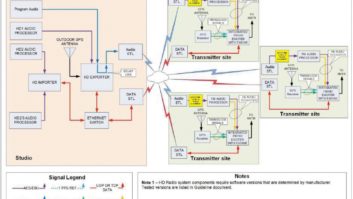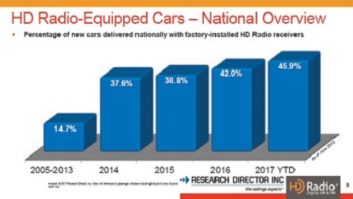The fix for IBOC
Aug 1, 2003 12:00 PM
The evolution of HD Radio is currently in a state of suspended animation, thanks to a decision taken a few weeks ago by the National Radio Systems Committee.
The NRSC dropped a small but significant bomb by announcing that it was halting the standards-setting process for HD Radio because of a problem with compression algorithms. Its DAB subgroup was worried that the PAC compression algorithm used for AM radio was just not good enough to be a systems standard and pointed to a recent demonstration as evidence. At this demonstration, at National Public Radio, several NRSC sources said they found the artifacts on the system using PAC �unacceptable.�
Ibiquity Digital, which is attempting to forge a standard for digital radio, was offered two possible options to address its IBOC problem. The first was �tweaking� the PAC algorithm; the second was reverting to another coding algorithm such as AAC or MPEG � all of which are based on psycho-acoustic principles.
It has been well documented in the past 10 years that the number of destructive psycho-acoustic-based algorithms in the audio broadcast chain could, in theory, introduce artifacts. It is arguable that the use of PAC as the final emission for IBOC simply highlights this problem, but then again, implementation of a low bit rate algorithm for the final leg of HD Radio was always going to accentuate existing problems as well as introduce new artifacts. Using other psycho-acoustic-based compression algorithms, i.e. AAC or MPEG, may marginally alleviate the artifacts but this would only offer an incremental improvement. One �tweaked� algorithm can only offer a very slight incremental improvement, and even that is largely dependent on the source material � for example, talk or music. To fundamentally confront the problem, broadcasters need to address the entire broadcast chain, which suggests that the current approach is not actually addressing the true problem.
We at APT � Audio Processing Technology – have long been recommending that broadcasters take more care of their content. We suggest a reduction in the number of psycho-acoustic passes in the broadcast chain and, where compression is required, the use of a non-destructive gentler ADPCM compression algorithm such as apt-X; a concept that has been proven with GWR and The Capital Group, following the launch of DAB in the UK.
Until broadcasters take ownership of the problem, then the artifacts in audio emitted via IBOC will remain. The only point of contention is how noticeable these artifacts will be to the listener. If AM HD Radio output appears in the form of gritty, unnatural-sounding voices then artifacts will be noticed. Even if the artifacts are slightly subtler, Listener Fatigue will be the final result.
Research suggests that listener fatigue makes people �tune-out� by flicking across the dial. In the world of commercial radio, losing listeners ultimately equates to a loss of revenue as advertising sales rely on healthy audience figures.
To summarize in the form of an analogy, if a house has serious cracks in its walls, then papering them over would not solve the problem. The only way to stop the house from falling down is to take a good look at its foundations and see what needs to be done. The same applies to the current problems faced by IBOC. Until broadcasters take ownership of the cascading and concatenation issue and reduce the number MPEG passes, then all investments in HD Radio will have a very poor return.
Jon McClintock
commercial director, APT
Belfast, Ireland












